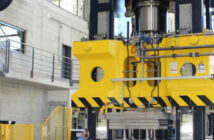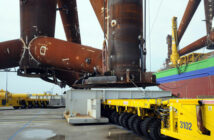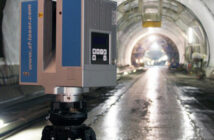The steel reinforcements of concrete structures require regular inspections. In Germany, DIN 1076 prescribes specific test procedures and measurements. The Profometer concrete testing instrument from Proceq AG, Schwerzenbach, Switzerland is frequently used for locating steel reinforcement in concrete structures. The tester manufactured by this Zurich-based company measures the difference in potential between concrete surface and the reinforcement. The difference in potential of several 100 mV enables precise localisation of the steel reinforcement in concrete structures using the Proceq Profometer.
Structural inspection of reinforcement in concrete structures: fixed intervals, fixed inspection schedule.
In Germany, DIN 1076 prescribes testing of concrete buildings and concrete structures (concrete bridges in particular) in six-year cycles where the first cycle is five years. The reason for this initial five-year cycle is the limitation period of five years for remedial claims. Both the simple and main tests involve measuring and analysing the strength of the concrete and corrosion of the steel reinforcement in concrete structures. The inspection team also focuses its attention of course on other items such as foundation erosion. Descriptions of some of the individual tests are shown in the following. The sequence, execution and the scope are uniformly defined.
Profometer: testing and measurement of the concrete cover
The concrete cover of the steel reinforcement constitutes an important parameter in the assessment of the concrete buildings and concrete structures. Concrete testing instruments and especially magnetic inductive measuring systems such as the Profometer Proceq are used for this purpose. Magnetic inductive measuring instruments offer clear advantages in this case by enabling non-destructive localisation of individual rebars in in-situ concrete. Similar of course to other measurement systems available on the market, the Proceq Profometer can localise down to a depth of about 10 cm with high precision. This is due to the measuring method used. Remaining with this example tester: the Proceq Profometer 3, Proceq Profometer 4, Proceq Profometer 5, Proceq Profometer 5+ and Proceq Profometer 5s testers are often used in Germany.
In addition to capabilities for localising and checking the position of the steel reinforcement, as a concrete testing instrument the Proceq Profometer also offers a function for measuring the thickness of the concrete cover of the steel reinforcement. This method is also non-destructive, which is an important advantage when using the instrument. Advance information on diameter of the rebars is required for this purpose. This information should be indicated in the planning documents however.
The determination of the compressive strength, elastic modulus
Non-destructive concrete sampling is not possible. Nevertheless, taking samples of the concrete of concrete buildings or concrete structures is essential for determining the compressive strength of the concrete. Wet drilling is the method primary used for taking samples here. In this case, the concrete samples taken are what are known as drill cores. If the sampling drilling encounters steel reinforcement, the drilling must be repeated elsewhere.
In order to damage the concrete structure as little as possible and weaken it only minimally, the possible locations of reinforcements in concrete are determined before starting to wet-drill holes to take samples. Magnetic inductive measuring systems such as the Proceq Profometer are used again for this purpose. The drill core sample is then subjected to a pressure test in a press. This determines the compressive strength of the concrete.
The Raschel sound test is the method used to determine loose parts and cavities in concrete structures.
This method is relatively simple and is usually just as non-destructive. The sound test involves systematically tapping the surface of the concrete with a hammer. The individual tone of the knocking sound reveals cavities in the concrete and areas with loose parts. This change in tone is so strong that defective points can be identified in the concrete easily and accurately. This method is nicknamed „Raschelmethode“ and is used without exception for all inspections carried out on concrete buildings and concrete structures.
Schmidt hammer test: a rebound hardness test using a rebound hammer invented by Swiss engineer Ernst Schmidt
Inspecting concrete can be difficult and problematic when inaccessible points where concrete samples are to be taken are encountered. It is frequently the case, however, that although the point in the concrete structure where a core sample is to be taken is easily accessible for the wet drilling device, the unit cannot be set up alone due to the lack of space. In these instances, the likewise non-destructive Schmidt hammer testing method is used. The Schmidt hammer test is applied at specific points to measure the compressive strength of concrete. This method takes its name from the Schmidt hammer or rebound hammer used for this purpose.
It is primarily the uniformity of the in-situ concrete that is measured with the rebound hardness test or Schmidt hammer test. Points with low quality concrete can be quickly identified. The points to be identified of course include damaged concrete in concrete buildings and concrete structures.
The DIN EN 12504-2: 2001 permits an estimate of the strength of in-situ concrete via correlation. On the other hand, this regulation prohibits determination of strength on the basis of an estimate. For this reason, inspection of concrete structures and testing of the rebound hardness are necessary. In this case, the Schmidt hammer test ultimately provides certainty.
The Hilti Ferro PS 200 non-destructive reinforcement scanner
Scanning for the steel reinforcement in a concrete structure should be carried out without affecting the basic structure of an object, i.e. as non-destructively as possible. The Hilti Ferroscan PS 200 is a portable scanner that is often used exactly for this purpose. It is portable and easy to use and is able to locate the position of reinforcement. In addition to determining the position of reinforcement, the unit is also able to estimate the diameter of the reinforcement and measure the thickness of concrete cover. The areas of applications include locating steel ties and analysing the structure of whole objects.
Other specific tests can be found on the website of the Bayerischen Kommunalen Prüfungsverband [Bavarian Municipal Auditing Association].
Portable hardness testers from Schwerzenbach, Switzerland
Proceq SA has been developing and producing high-quality measuring and testing instruments for over sixty years and has ultimately built its success on the non-destructive testing of materials. The company has become established at its site in Schwerzenbach situated in the Swiss canton of Zurich. Proceq’s target group is not just the concrete industry, but also includes the entire metal and paper industries.
Proceq SA in Schwerzenbach: Processes + Equipment
As previously indicated, concrete and reinforcement are just one segment of Proceq SA’s portfolio. The company was founded in Zurich on 8 April 1954. The name was derived from the words „processes“ and „equipment“. The Proceq Profometer model range has become rather extensive in the meantime. The Profometer 4, Profometer 5 and Profometer 5s models have become known quantities in the concrete, metal and paper industries.
Photo credits: © unsplash.com – Charlie Foster










